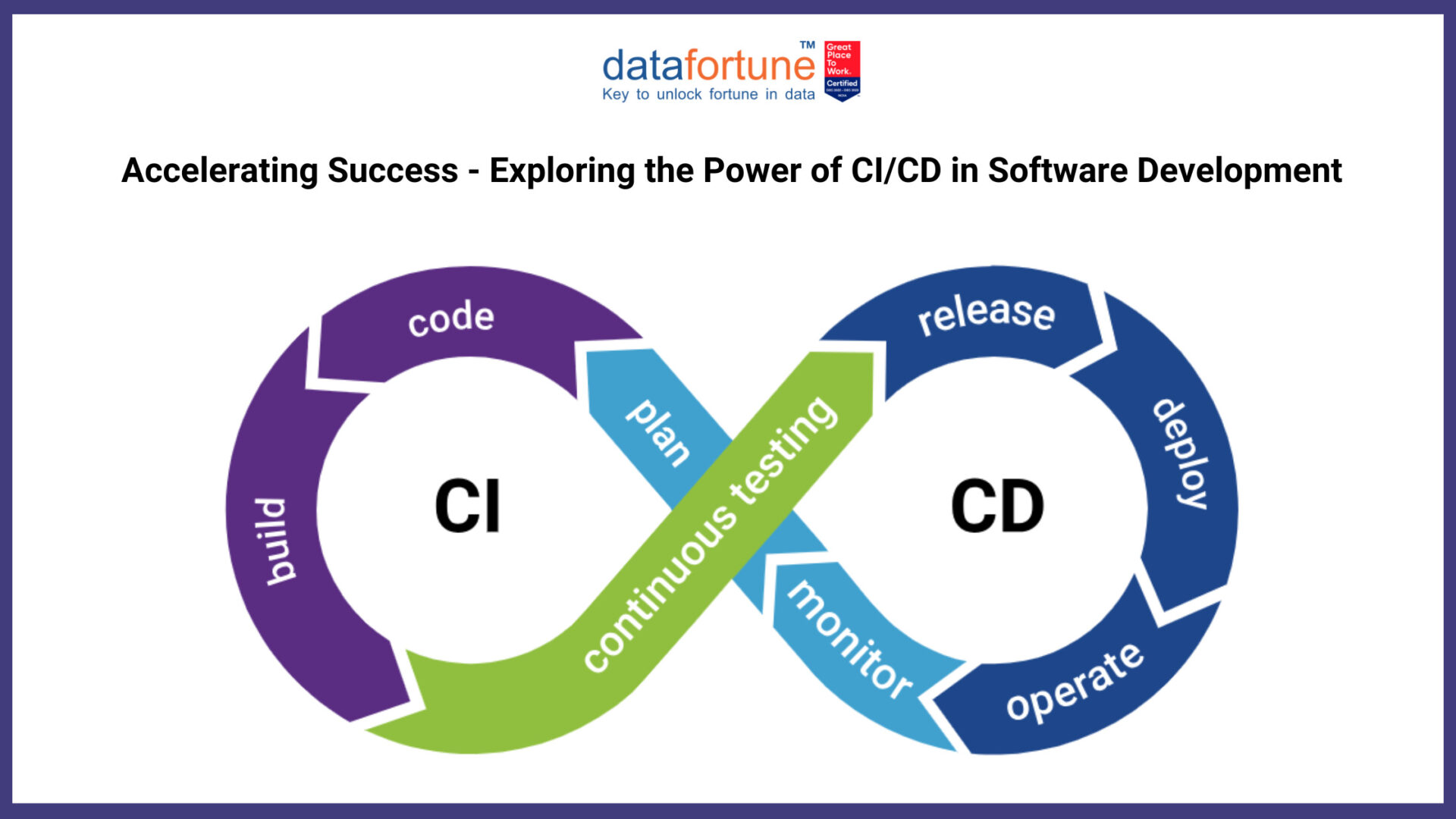Accelerating Success – Exploring the Power of CI/CD in Software Development
In an era where technology is the engine driving organizational growth, the adoption of robust software development practices is no longer a luxury but a necessity. Among these practices, Continuous Integration and Continuous Delivery (CI/CD) emerge as critical components in streamlining software development and deployment. Datafortune, a premier software development company in the USA, staunchly advocates for the assimilation of CI/CD pipelines in development processes to foster innovation and accelerate delivery.
Understanding CI/CD
Continuous Integration (CI) is a practice where developers integrate code into a shared repository multiple times a day. Each integration is then automatically verified by an instance of automated tests to detect integration errors as quickly as possible. Continuous Delivery (CD), on the other hand, is an extension of CI, ensuring that new changes to the software are releasable at any moment in a sustainable way.
The Indispensable CI/CD
The nexus of Continuous Integration and Continuous Delivery (CI/CD) in software development is instrumental in eliminating the hurdles traditionally associated with the development and deployment of software solutions.
Agile Alignment
CI/CD practices dovetail with Agile software development methodologies, fostering an environment of continuous improvement, and promoting a culture of shared responsibility for the codebase.
Automation Affluence
Automation is at the heart of CI/CD. From integration testing to deployment automation, CI/CD pipelines significantly reduce manual intervention, thus minimizing errors and accelerating the delivery process.
Rapid Release Management
By embracing CI/CD, organizations can achieve rapid software deployment, ensuring quicker delivery of features and fixes to the market. The automated deployment pipeline facilitates streamlined release management, enabling a consistent and reliable delivery process.
Statistical Spotlight
Research underscores the tangible benefits accrued from CI/CD implementation. According to a report by Puppet, organizations that have embraced CI/CD report 208 times more frequent code deployments and 106 times faster lead time from commit to deploy compared to their counterparts.
CI/CD Best Practices
- Version Control Systems: Employ version control systems to track every change and ensure traceability.
- Continuous Testing: Embed testing within the CI/CD pipeline to catch bugs early in the development lifecycle.
- Deployment Automation: Leverage deployment automation tools to ensure consistent and reliable delivery.
The Genesis of CI/CD
The inception of Continuous Integration and Continuous Delivery (CI/CD) stems from the desire to mitigate the challenges of traditional software development and deployment. Historically, the segregated phases of development, testing, and deployment created silos that hindered communication and collaboration. CI/CD emerged as a solution to break down these barriers and cultivate a more unified, efficient approach to software development.
CI/CD: The Core Components
Continuous Integration (CI)
Integration Testing: Continuous integration encourages a culture of frequent integration testing to detect and rectify issues early, reducing the bug-fixing efforts at later stages.
Version Control Systems: Utilizing version control systems is fundamental to tracking changes, maintaining a single source of truth, and ensuring a seamless integration process.
Continuous Delivery (CD)
Deployment Automation: Automated deployment is a cornerstone of CD, facilitating a swift, consistent, and reliable delivery process.
Release Management: CD enhances release management by ensuring that the codebase is always in a deployable state, thus enabling rapid and predictable deliveries.
The Benefits Galore
Enhanced Collaboration
CI/CD promotes a collaborative culture by fostering open communication and feedback among developers, testers, and operations teams, hence bridging the traditional gaps that existed between these groups.
Increased Deployment Frequency
With CI/CD, organizations can transition from monolithic, infrequent releases to smaller, more frequent deployments. This frequency accelerates the feedback loop and enables quicker resolution of issues.
Reduced Deployment Failures
The practice of CI/CD minimizes the risk of deployment failures. The automated testing and integration in a CI/CD environment ensure that bugs are identified and fixed promptly, thus enhancing the software quality.
The Technology Tapestry Of Datafortune
DevOps and CI/CD: A Harmonious Duo
The principles of CI/CD are the bedrock upon which DevOps practices are built. CI/CD pipelines play a pivotal role in achieving the collaboration and automation goals central to DevOps.
Automation Tools
Numerous automation tools are available to facilitate CI/CD implementation. Tools like Jenkins, CircleCI, and Travis CI are instrumental in setting up CI/CD pipelines, thus enhancing software development efficiency.
Jenkins:
Jenkins is an open-source automation server that facilitates the reliable building, testing, and deployment of code. With its vast plugin ecosystem, Jenkins is adaptable to a wide variety of project needs, making it a staple for many organizations looking to implement CI/CD pipelines. At Datafortune, Jenkins is one of the primary tools used for these purposes, aiding in the continuous and consistent delivery of software solutions.
GitLab:
GitLab is a complete DevOps platform delivered as a single application. It encompasses Git repository management, code reviews, issue tracking, CI/CD pipelines, and more. Its built-in CI/CD component simplifies the process of setting up and managing pipelines, promoting a more streamlined development lifecycle. At Datafortune, GitLab’s integrated approach to CI/CD makes it a frequently used tool for achieving efficient and collaborative software development.
CI/CD at Datafortune
At Datafortune, we embody the ethos of continuous improvement through our robust CI/CD practices. As a top software company in the USA, we are at the forefront of leveraging CI/CD in software development to drive operational efficiency and deliver unparalleled value to our clients.
Conclusion
The journey from code to deployment is laden with potential pitfalls. However, with CI/CD, organizations can significantly smoothen this journey, ensuring rapid, reliable, and robust software delivery. At Datafortune, we are committed to harnessing the power of CI/CD to propel your business to greater heights. Discover a world of seamless software development and deployment with Datafortune, your trusted software development partner in the USA.
For more insights on how CI/CD can revolutionize your software development processes, reach out to us at +1(404)-382-0885 and info@datafortune.com.



